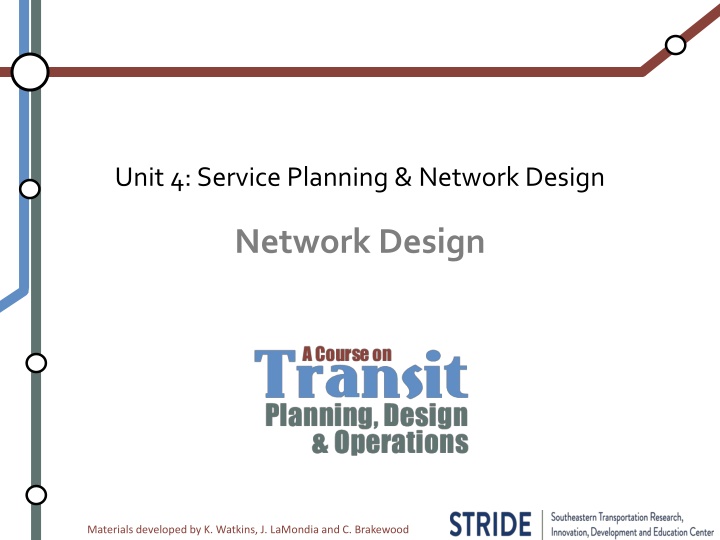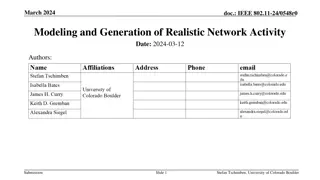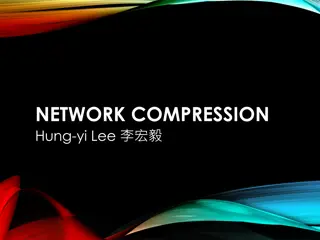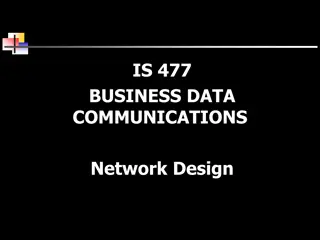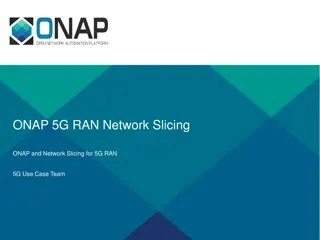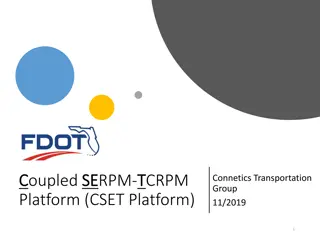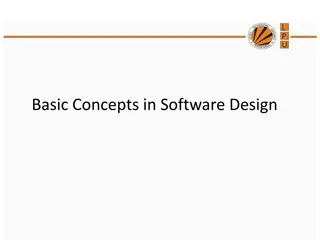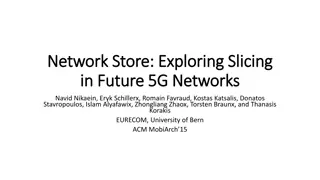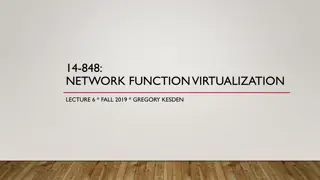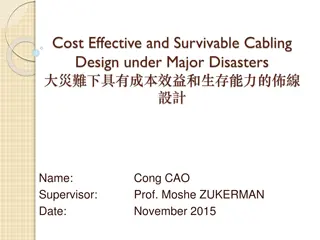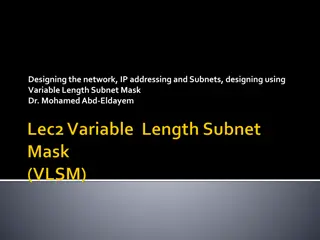Network Design
This content delves into the stages of service planning, network design decisions, and objectives. It explores topics such as route design, frequency determination, connectivity choices, and operating efficiency in transportation network design. Developed by K. Watkins, J. LaMondia, and C. Brakewood, these materials offer valuable insights into creating efficient and user-friendly transit systems.
Download Presentation

Please find below an Image/Link to download the presentation.
The content on the website is provided AS IS for your information and personal use only. It may not be sold, licensed, or shared on other websites without obtaining consent from the author.If you encounter any issues during the download, it is possible that the publisher has removed the file from their server.
You are allowed to download the files provided on this website for personal or commercial use, subject to the condition that they are used lawfully. All files are the property of their respective owners.
The content on the website is provided AS IS for your information and personal use only. It may not be sold, licensed, or shared on other websites without obtaining consent from the author.
E N D
Presentation Transcript
Unit 4: Service Planning & Network Design Network Design Materials developed by K. Watkins, J. LaMondia and C. Brakewood
Outline Stages of Service Planning Network Design Overview Types of Lines Network Types Materials developed by K. Watkins, J. LaMondia and C. Brakewood
STAGES OF SERVICE PLANNING Materials developed by K. Watkins, J. LaMondia and C. Brakewood
Service Planning Steps Network design Route design and stop layout Frequency determination Timetabling Vehicle scheduling Crew scheduling Materials developed by K. Watkins, J. LaMondia and C. Brakewood
Service Planning Steps Network design Route design and stop layout Frequency determination Timetabling Vehicle scheduling Crew scheduling Materials developed by K. Watkins, J. LaMondia and C. Brakewood
NETWORK DESIGN OVERVIEW Materials developed by K. Watkins, J. LaMondia and C. Brakewood
Network Design Decisions Rare to approach from scratch Existing route patterns & infrastructure dictate New services complement existing services New major investment (rail line, etc) Significant restructuring Materials developed by K. Watkins, J. LaMondia and C. Brakewood
Network Design Decisions Geographic coverage Temporal coverage Connectivity (direct vs. indirect service) Experiment with network structures and routes Travel demand models Link major activity centers Materials developed by K. Watkins, J. LaMondia and C. Brakewood
Network Design Objectives Passenger Attraction Maximum transportation work Network Operating Efficiency Maximum operating efficiency Network-City Interactions Create positive impacts Materials developed by K. Watkins, J. LaMondia and C. Brakewood
TYPES OF TRANSIT LINES Materials developed by K. Watkins, J. LaMondia and C. Brakewood
Types of Transit Lines Radial Diametrical Tangential Circumferential Trunk with branches Trunk with feeder Loops on lines Materials developed by K. Watkins, J. LaMondia and C. Brakewood
Radial One terminus in city center and another outside Sharp peaking Can be used with branching Materials developed by K. Watkins, J. LaMondia and C. Brakewood
Diametrical (through) Connect suburbs on both sides through the city center Inbound delays propagate Materials developed by K. Watkins, J. LaMondia and C. Brakewood
Tangential (crosstown) Run tangent to city Common with grid patterns Lower & less peaked demand Materials developed by K. Watkins, J. LaMondia and C. Brakewood
Circumferential Ring around city Suburb-to-suburb connections without trip into city More connections No terminal time Moscow Materials developed by K. Watkins, J. LaMondia and C. Brakewood
Trunk lines Trunk with branches Trunk with feeders Materials developed by K. Watkins, J. LaMondia and C. Brakewood
Trunk lines Trunk with branches + Continuous service with no transfers + No transfer stations + Less terminal time Trunk with feeders + Each line optimized + Higher performance mode on trunk + More reliable + Feeder to feeder transfers Materials developed by K. Watkins, J. LaMondia and C. Brakewood
Frequencies One key to quality of service What do branches mean for frequency? Materials developed by K. Watkins, J. LaMondia and C. Brakewood
Frequencies One key to quality of service What do branches mean for frequency? One of three things: 1. Branches have less frequent service 2. One branch connects into another 3. Vehicle separates onto both (rare) Materials developed by K. Watkins, J. LaMondia and C. Brakewood
Loops on Lines Closed circle Usually one-way operation Distribution in CBD Chicago Materials developed by K. Watkins, J. LaMondia and C. Brakewood
Directness Most examples so far were rail Bus routes often deviate to serve lower densities Direct Circuitous Deviating I, U, S, O Materials developed by K. Watkins, J. LaMondia and C. Brakewood
In-class Exercise Materials developed by K. Watkins, J. LaMondia and C. Brakewood
TRANSIT NETWORK TYPES Materials developed by K. Watkins, J. LaMondia and C. Brakewood
Transit Network Types Radial networks Radial / circumferential networks Rectangular or grid networks Ubiquitous networks Materials developed by K. Watkins, J. LaMondia and C. Brakewood
Radial Networks + Maximize ridership along major travel direction + Limited transfers Extreme concentration in CBD Unattractive for crosstowns Less coverage area METRA in Chicago Materials developed by K. Watkins, J. LaMondia and C. Brakewood
Radial / Circumferential Networks Radial with a ring or tangent Greater diversity of origin / destination Greater coverage Koln, Germany Materials developed by K. Watkins, J. LaMondia and C. Brakewood
Grid Networks Large area with uniform density Coverage Substantial transfers Materials developed by K. Watkins, J. LaMondia and C. Brakewood
Joy of Grids Ability to travel from anywhere to anywhere Mathematically, the most efficient manner is a grid Why? Rectangular Spiderweb Materials developed by K. Watkins, J. LaMondia and C. Brakewood
Ubiquitous Networks Coverage over all central area + Radiating out with branches into suburbs = perfect network Most complete ubiquitous network in the world: Paris!! New York is OK too. Materials developed by K. Watkins, J. LaMondia and C. Brakewood
Network Issues Radial lines with branches lead to unused capacity at ends Different lengths / volume branches make irregular trunks Diametrical with different loads Triangular connections hard to schedule Materials developed by K. Watkins, J. LaMondia and C. Brakewood
Conclusion It is rare to approach network design from scratch Existing route patterns & infrastructure dictate New services complement existing services Network design determines many factors of service quality Materials developed by K. Watkins, J. LaMondia and C. Brakewood
Reference Materials in this lecture were taken from: Walker, J. (2011). Human transit: How clearer thinking about public transit can enrich our communities and our lives. Island Press. Vukan Vuchic, Urban Transit Operations, Planning and Economics (2005) Mark Hickman, Fundamentals of Transportation wikibook, Network Design & Frequency , http://en.wikibooks.org/wiki/Fundamentals_of_T ransportation/Network_Design_and_Frequency Materials developed by K. Watkins, J. LaMondia and C. Brakewood
